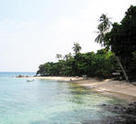
Sarawak. Sarawak is located on the island of Borneo. Sarawak is the largest of Malaysia's 13 States. It is home to Batang Rajang, the country’s longest river, and Mulu, the world’s most extensive cave system. Holding the world’s oldest and second largest tropical rainforest after the Amazon, Sarawak is a marvel of biodiversity. Sarawak also known as the Land of Hornbills. It is naturally blessed with vast areas of both lowland and highland rainforest. The rainforest is home to an incredible variety of more than 8,000 species of flora and over 2,000 fauna, the majority of which are insects. Sarawak also rich in culture, history and heritage. Sarawak is presently divided into 11 administrative divisions; Kuching, Kota Samarahan, Sri Aman, Betong, Sarikei, Sibu, Kapit, Bintulu, Mukah, Miri and Limbang. Kuching is the state capital and seat of the government. Day 1 - Upon arrival at Kuching International Airport, meet and proceed to Kuching City Tour. The perfect introduction to Sarawak’s historic capital, this tour includes Kuching’s Chinatown, the Cat Statue (Kuching means “Cat” in Malay), the colourful Tua Pek Kong Chinese Temple, the Civic Centre Viewing Platform and the world famous Sarawak Museum. Across river, visit the unique Cat Museum, passing the magnificent State Mosque and the Astana, the former residence of the White Rajahs. Return via the golden-domed City Mosque and proceed on foot through Old Kuching, visiting the colourful Central Markets and squeezing through narrow alleyways crammed with spice dealers and textile shops. Pass by the heritage buildings of the White Rajah era, the Pavilion, the Square Tower, the Court House, the Charles Brooke Monument and the Post Office. Day 2 - Breakfast at the hotel, depart for Semenggok Forest Reserve, the best place in Sarawak to view semi-wild orang utans, who have been rescued from captivity and trained to survive in the surrounding forest reserve. The rehabilitated animals roam freely in the rain forest, and often return to the centre at feeding time. Thanks to the successful breeding programme at Semonggok there is a good possibility of experiencing one of the most heart-warming sights in Borneo - an orang utan mother with a young baby. The centre is 30 mins drive from Kuching and another 20 mins on foot. Along the way visitors pass by the ethno-botanical gardens, with their unique collection of rain-forest plants. Semengok also has a number of short collection of rain-forest plants. Semengok also has a number of short jungle trails and optional forest walks can be incorporated into the tour. (Note : As the orang utan in Semengok are semi-wild, sightings cannot be guaranteed.) Transfer to Sarawak Cultural Village. This award-winning living museum showcases Sarawak’s unique and diverse cultures in an accessible, visitor-friendly setting just 35 minutes from Kuching. The seven authentic traditional buildings are set amidst a scenic 17 acre site and are populated by members of Sarawak’s many ethnic groups, going about everyday activities. These include wood and bamboo carving, beadwork, weaving, sago-making, sugar-cane crushing, pepper-growing and the preparation of bird’s nests. Visitors can learn how to throw a Malay spinning top, shoot a Penan blowpipe or pick out a tune on an Orang Ulu sape. The tour concludes with a colourful multi-ethnic cultural performance in the village’s air-conditioned mini-theatre. Day 3 - Breakfast, Free at leisure until transfer to Kuching International Airport for your departure flight (B) .





